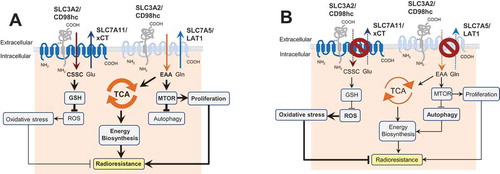Figures & data
Figure 1. The role of SLC3A2 in regulation of autophagy activation and cell radiosensitivity. (A) In HNSCC cells, SLC3A2 and its light chain subunit SLC7A5 play an important role in transport of essential amino acids (EAA) such as histidine, isoleucine, leucine, methionine, valine, tryptophan, phenylalanine and threonine as well as conditionally essential ones such as cysteine and tyrosine. This amino acid transport is important for biosynthesis, energy production in the tricarboxylic acid cycle (TCA cycle), and activation of the MTOR signaling pathway. SLC3A2 is also associated with the cystine (CSSC) transporter SLC7A11 which is critical for synthesis of glutathione, one of the major scavengers of reactive oxygen species (ROS). (B) Blocking of the SLC3A2-dependent amino acid transport inhibits the MTOR pathway, downregulates the TCA cycle and restrains tumor cell proliferation. This results in the activation of autophagy as a pro-survival mechanism.

